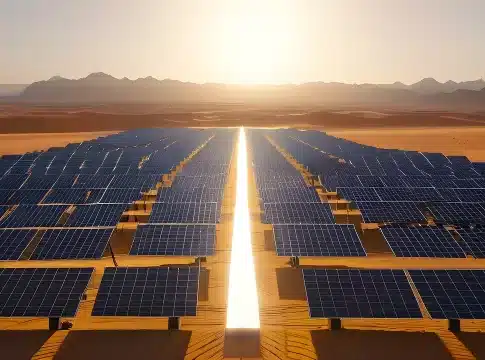America to See a Surge in Renewable Capacity in 2024
The United States is poised for a significant boost in renewable energy capacity by over 67 gigawatts (GW) in 2024, driven by policy shifts and economic factors, per S&P Global Market Intelligence analysis. Solar energy, in particular, is set to lead the charge, with over 56 GW of capacity expected to come online.
This surge reflects a broader trend toward cleaner energy sources and marks a pivotal moment in America’s energy transition. Additionally, around 11 GW of wind generation and 21 GW of energy storage are projected to come online.
Solar Dominance in America’s Energy Landscape
While natural gas has been considered a transitional fuel, the analysis indicates a net gain of only 394 megawatts (MW) of natural gas capacity in 2024. This is overshadowed by planned retirements, with 4,028 MW of natural gas expected to be retired.
The only new nuclear capacity addition is the 1,114-MW unit 4 at the Vogtle Nuclear Plant in Georgia.
But the International Energy Agency (IEA) forecasted that nuclear power will reach an all-time high in 2025. Industry experts also believe that nuclear will start to soar this year.
RELEVANT: How Nuclear Energy in the U.S. Got Its Groove Back, Poised to Soar in 2024
US Energy Secretary Jennifer Granholm recently stated that wind and solar energy could surpass coal generation for the first time in US history. The trend towards cleaner energy sources will continue, to achieve 80% clean energy on the path to 100% clean electricity by 2035.
In 2024, around 5 GW of fossil-fired capacity will retire, which is less than half of the previous year’s total. Of this, around 3,634 MW of gas-fired capacity and 1,035 MW of coal-fired resources will shut down.
However, the challenges and opportunities of the energy transition are evident, particularly in grid operator PJM Interconnection LLC.
PJM has seen a surge in renewables, prompting concerns about reliability risks. Solar energy has surpassed natural gas in new service requests, indicating a shift in the energy landscape.
Cargill’s Sustainable Power Partnership
Solar energy is taking the lead in the energy landscape, with 56 GW of solar capacity this year. Within the PJM Interconnection region alone, around 9 GW of solar capacity is anticipated.
READ MORE: Harnessing the Sun: America’s Solar Snapshot in April 2024
PJM plans for about 10 GW of new capacity additions in 2024, with minimal retirements of just 80 MW from wind generation.
Cargill Inc., a major player in the food industry, has expanded its renewable energy portfolio by contracting an additional 300 MW of wind and solar capacity. With this addition, Cargill’s offsite renewable energy portfolio now stands at 716 MW.
The company has entered into five power purchase agreements (PPAs) to bring online the new wind and solar capacity. However, the specific locations of these new generating resources were not disclose.
Still, once operational later this year, they can help Cargill reduce its carbon emissions by nearly 820,000 metric tons/year.
Cargill’s global renewable energy portfolio comprises 15 projects across 12 countries. These include virtual PPAs with:
Ocean Breeze Energy GmbH & Co. KG for 35 MW from the Bard offshore wind farm in Germany,
Galileo Green Energy GmbH for 55 MW from a solar project in Italy,
Vattenfall AB for 78 MW from the Hanze Windpark project in the Netherlands,
TC Energy Corp. subsidiary Blue Cloud Wind Energy LLC for 130 MW from a Texas wind farm, and
A self-production contract for generation from a wind farm in Bahia, Brazil.
Regional Insights into Renewable Energy Expansion
The Electric Reliability Council of Texas Inc. (ERCOT) will also see over 27 GW of new resources added in 2024, including over 16 GW of solar capacity, according to S&P Global. Additionally, nearly 8 GW of energy storage, over 2 GW of wind resources, and 790 MW of natural gas generation are part of the planned capacity additions.
California ISO will also add over 12 GW of capacity, with 5 GW and 7 GW, from solar and energy storage, respectively. ISOs refer to independent system operators.
In the Midcontinent ISO (MISO) region, over 12 GW of capacity additions are projected. Meanwhile, the retirement in this region will be at 1,368 MW of fossil fuel generation.
ISO New England is forecast to add over 2 GW of capacity, offset by 1,692 MW of natural gas retirements. Meanwhile, the New York ISO region will add 2,044 MW of capacity in 2024.
Within the Southwest Power Pool (SPP) region, about 2 GW of renewable capacity additions are anticipated, along with 788 MW of natural gas additions.
Outside of formal ISO or RTO regions, approximately 25 GW of capacity additions and 2 GW of retirements are forecasted. This includes over 14 GW of solar projects, followed by over 4 GW of energy storage, 2 GW of wind, and 2 GW of gas.
As the US continues its transition towards a more sustainable energy future, the surge in renewable energy capacity in 2024 underscores the nation’s commitment to combating climate change and embracing clean energy solutions.
READ MORE: US EPA to Invest $20B in Climate and Clean Energy Projects for Underserved Communities
The post America to See a Surge in Renewable Capacity in 2024 appeared first on Carbon Credits.



